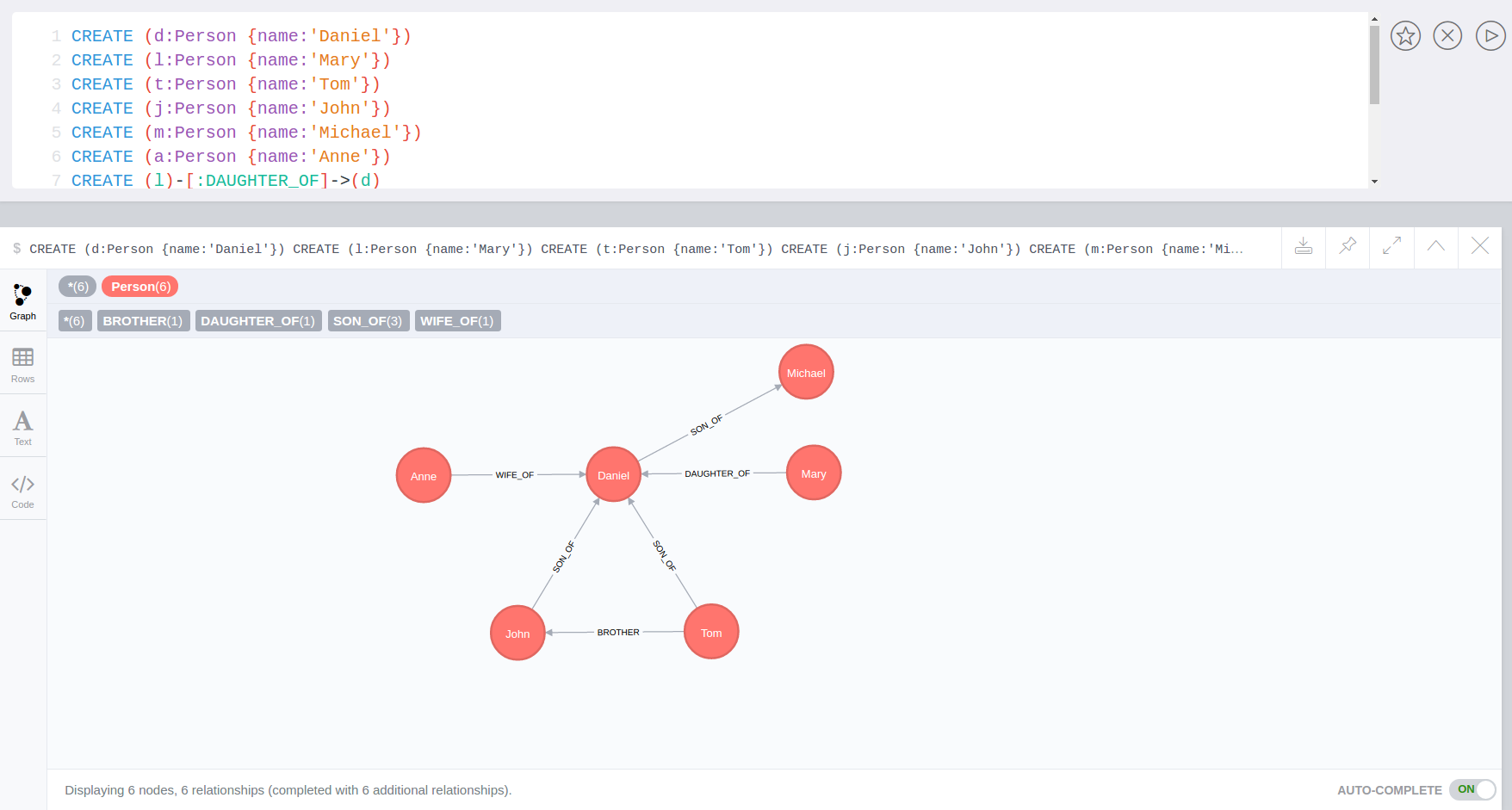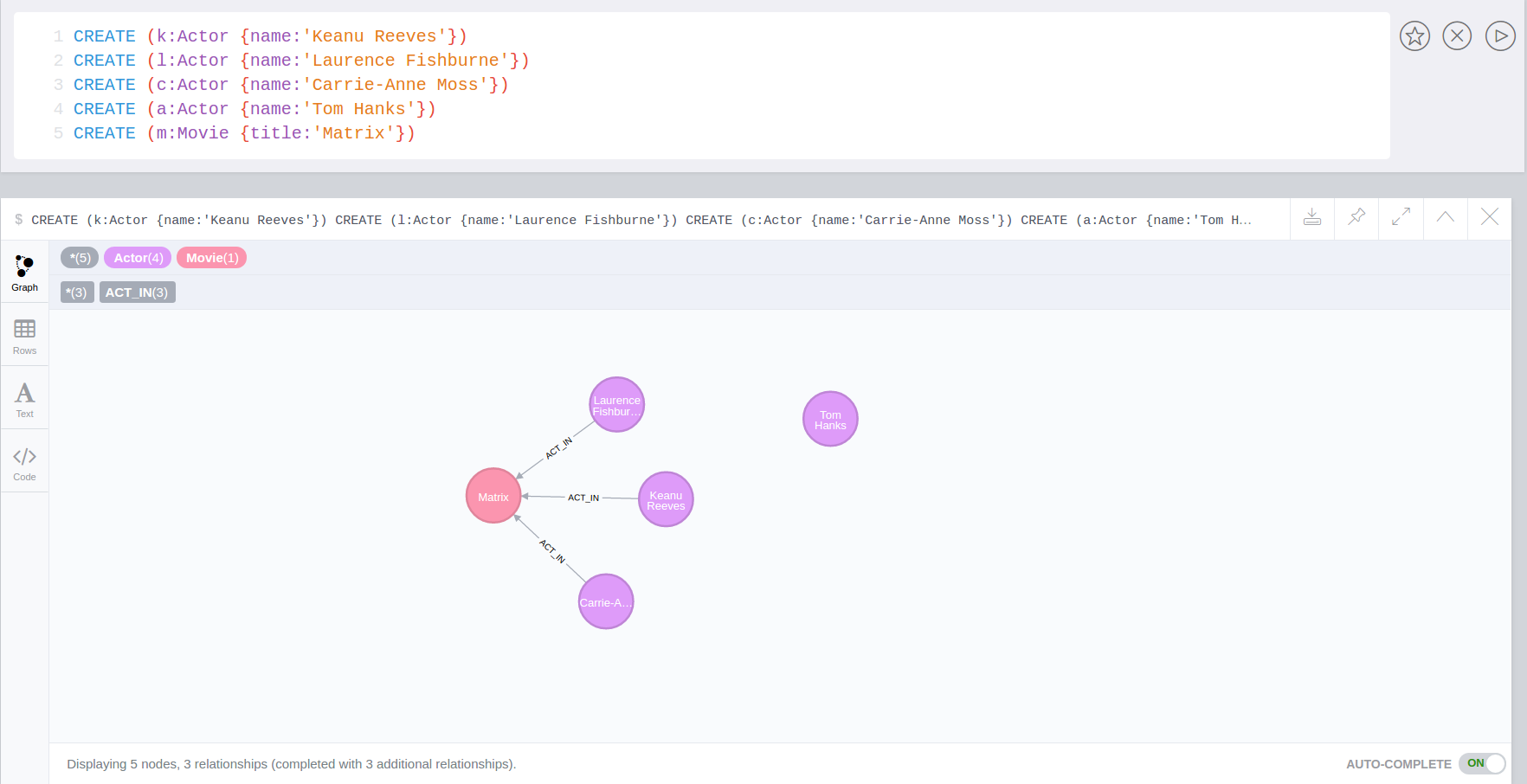Triggers
Triggers allow the registration of Cypher queries that are called when data in Neo4j is changed (created, updated, deleted). Triggers can be run before or after a commit.
|
The There are several ways of doing this:
Moreover, the |
|
Installing, updating, or removing a trigger is an eventually consistent operation.
Therefore, they are not immediately added/updated/removed,
but have a refresh rate handled by the APOC configuration |
By default triggers are disabled.
We can enable them by setting the following property in apoc.conf:
apoc.trigger.enabled=true
apoc.trigger.refresh=60000| Option Key | Value | Description |
|---|---|---|
apoc.trigger.enabled |
true/false, default false |
Enable/Disable the feature |
apoc.trigger.refresh |
number, default 60000 |
Interval in ms after which a replication check is triggered across all cluster nodes |
| Qualified Name | Type |
|---|---|
apoc.trigger.drop |
|
apoc.trigger.dropAll |
|
apoc.trigger.install |
|
apoc.trigger.list |
|
apoc.trigger.show |
|
apoc.trigger.start |
|
apoc.trigger.stop |
|
The transaction data from Neo4j is turned into appropriate data structures to be consumed as parameters to a statement, i.e. $createdNodes.
The parameters available are:
| Statement | Description |
|---|---|
|
returns the id of the transaction. Note that this value only works with the 'after' and 'afterAsync' phases (see the Trigger Phase Table).
Otherwise, it has the value |
|
returns the date of the transaction in milliseconds |
|
when a node is created our trigger fires (list of nodes) |
|
when a relationship is created our trigger fires (list of relationships) |
|
when a node is deleted our trigger fires (list of nodes) |
|
when a relationship is deleted our trigger fires (list of relationships) |
|
when a label is removed our trigger fires (map of label to list of nodes) |
|
when a properties of node is removed our trigger fires (map of key to list of map of key,old,node) |
|
when a properties of relationship is removed our trigger fires (map of key to list of map of key,old,relationship) |
|
when a labes is assigned our trigger fires (map of label to list of nodes) |
|
when node property is assigned our trigger fires (map of key to list of map of key,old,new,node) |
|
when relationship property is assigned our trigger fires (map of key to list of map of key,old,new,relationship) |
|
a map containing the metadata of that transaction. Transaction meta data can be set on client side e.g. via https://neo4j.com/docs/api/java-driver/current/org.neo4j.driver/org/neo4j/driver/TransactionConfig.html#metadata() |
The third parameter of the apoc.trigger.install() is a map {phase: PHASE}, where PHASE is a string that can have one of the following values:
|
Description |
|
The trigger will be activated |
|
The trigger will be activated right after the |
|
The trigger will be activated |
|
The trigger will be activated |
|
Unlike previous versions of Neo4j, it will not be possible using Neo4j 5 to modify an entity created in phase: “after”.
For example, the following query will return an Exception with message It is instead necessary to use another phase or perform only reading operations. |
Triggers Examples
It is possible to add a trigger which, when added to a specific property on a node, adds the same property to all nodes connected to this node.
Dataset (in default database 'neo4j')
CREATE (d:Person {name:'Daniel', surname: 'Craig'})
CREATE (l:Person {name:'Mary', age: 47})
CREATE (t:Person {name:'Tom'})
CREATE (j:Person {name:'John'})
CREATE (m:Person {name:'Michael'})
CREATE (a:Person {name:'Anne'})
CREATE (l)-[:DAUGHTER_OF]->(d)
CREATE (t)-[:SON_OF]->(d)
CREATE (t)-[:BROTHER]->(j)
CREATE (a)-[:WIFE_OF]->(d)
CREATE (d)-[:SON_OF]->(m)
CREATE (j)-[:SON_OF]->(d)
With the above dataset, if a trigger is added and the following query is executed: MATCH (n:Person) WHERE n.name IN ['Daniel', 'Mary'] SET n.age=55, n.surname='Quinn', the $assignedNodeProperties used in the trigger statement will be as follows (where NODE(1) is (:Person {name: 'Daniel'}), and NODE(2) is (:Person {name: 'Mary'})):
{
age: [{
node : NODE(1),
new: 55,
old: null,
key: "age"
},
{
node: NODE(2),
new: 55,
old: 47,
key: "age"
}],
surname: [{
node: NODE(1),
new: "Quinn",
old: "Craig",
key: "surname"
},
{
node: NODE(2),
new: "Quinn",
old: null,
key: "surname"
}]
}The result is a map where the keys are the assigned properties, and the values are a list of entities involved.
Every element of a list have the node itself, the new value of the changed properties, the old value (or null if the property didn’t exist) and the key with the property name.
The $removedNodeProperties parameter has the same structure and logic (in this case, new values will be always null).
The same is true for assignedRelationshipProperties and removedRelationshipProperties, with the only difference being that the node: NODE(n) key is replaced with the relationship: RELATIONSHIP(n) key.
As an example, the following statement creates a trigger which for every SET, updates the two properties time and lasts
with the current date:
CALL apoc.trigger.install('neo4j', 'setLastUpdate',
"
UNWIND keys($assignedNodeProperties) AS k
UNWIND $assignedNodeProperties[k] AS map
WITH map.node AS node, collect(map.key) AS propList
MATCH (n)
WHERE id(n) = id(node) AND NOT 'lasts' in propList // to prevent loops
SET n.time = date(), n.lasts = propList
",
{phase: 'afterAsync'});Note that the apoc.trigger.install, as well as the apoc.trigger.drop, apoc.trigger.dropAll, apoc.trigger.stop and apoc.trigger.start,
have to be executed in the system database.
In the example above, MATCH (n) WHERE id(n) = id(node) is used to demonstrate that the node is found by id first, before setting its parameters.
However, it is more efficient to remove this command and instead change the penultimate row to: SET node.time = date(), node.lasts = propList.
Note that the condition AND NOT 'lasts' IN propList must be added to prevent an infinite loop as the SET command will trigger this query again.
It is then possible to execute the following query, after a time defined by the configuration apoc.trigger.refresh:
MATCH (n:Person {name: 'Daniel'}) set n.age = 123, n.country = 'Italy'Executing
MATCH (n:Person {name: 'Daniel'}) return nIt is possible to set the property time with today’s date, and lasts=['country','age'].
In cases where the surname property is added to a node, it’s added to all the nodes connected to it as well (in this case one level deep).
MATCH (d:Person {name:'Daniel'})
SET d.surname = 'William'To add a trigger that connects every new node with the label Actor and assign a specific value to the name property, run the following query:
CALL apoc.trigger.install('neo4j','create-rel-new-node',
"
UNWIND $createdNodes AS n
MATCH (m:Movie {title:'Matrix'})
WHERE n:Actor AND n.name IN ['Keanu Reeves','Laurence Fishburne','Carrie-Anne Moss']
CREATE (n)-[:ACT_IN]->(m)
",
{phase:'before'}
)CREATE (k:Actor {name:'Keanu Reeves'})
CREATE (l:Actor {name:'Laurence Fishburne'})
CREATE (c:Actor {name:'Carrie-Anne Moss'})
CREATE (a:Actor {name:'Tom Hanks'})
CREATE (m:Movie {title:'Matrix'})
In a trigger query with $deletedRelationships or $deletedNodes, it is not possible to retrieve the properties of the deleted entities using the cypher function properties(), because deleted entities are represented as virtual nodes and virtual relationships.
Instead, the trigger query has to use the apoc.any.properties function to retrieve properties of deleted nodes and relations:
CALL apoc.trigger.install('neo4j', 'createLogNodeOnDelete',
"
UNWIND $deletedNodes as deletedNode
CREATE (log:Log) (1)
SET log:$(labels(deletedNode)) (2)
SET log += apoc.any.properties(deletedNode) (3)
",
{phase: 'afterAsync'});| 1 | Creates a node with label Log for each deleted node. |
| 2 | Adds the labels of the deleted node to the Log node using dynamic labels.
Note that the labels are assigned to deleted nodes. |
| 3 | Adds the properties of the deleted node to the Log node using the apoc.any.properties function. |
Given this trigger, the labels and properties of deleted nodes would be assigned to a Log node as follows:
Person nodeCREATE (d:Person:Actor {name:'Daniel', surname: 'Craig'})Person nodeMATCH (n:Person {name: "Daniel"})
DETACH DELETE nLog nodeMATCH (n:Log) RETURN n| n |
|---|
(:Log:Person:Actor {surname: "Craig",name: "Daniel"}) |
To prevent certain transaction locks, it is generally recommended to use the afterAsync phase.
This will stop the query from pending indefinitely.
Note that the apoc.trigger.stop and the apoc.trigger.start procedures are eventually consistent.
It is therefore necessary to wait a set amount of time for the changes to propagate.
The waiting time is defined by the configuration apoc.trigger.refresh.
To pause a trigger without removing it for future purposes, use the following procedure:

To resume a paused trigger, use the following procedure:

Add \{params: {parameterMaps}} to insert additional parameters.
CALL apoc.trigger.install('neo4j', 'timeParams',
"UNWIND $createdNodes AS n SET n.time = $time",
{}, {params: {time: timestamp()}}
);CALL apoc.trigger.install('neo4j', 'timestamp',
"UNWIND $createdNodes AS n SET n.ts = timestamp()",
{});
CALL apoc.trigger.install('neo4j', 'lowercase',
"UNWIND $createdNodes AS n SET n.id = toLower(n.name)",
{});
CALL apoc.trigger.install('neo4j', 'txInfo',
"UNWIND $createdNodes AS n SET n.txId = $transactionId, n.txTime = $commitTime",
{phase:'after'});
CALL apoc.trigger.install('neo4j', 'count-removed-rels',
"MATCH (c:Counter) SET c.count = c.count + size([r IN $deletedRelationships WHERE type(r) = "X"])",
{})Remove triggers
To remove the trigger with name 'test' in 'neo4j' database, run the following query:
CALL apoc.trigger.drop('neo4j', 'test')To remove all triggers in 'neo4j' db, run the following query:
CALL apoc.trigger.dropAll('neo4j')List of triggers
It is possible to return the full list of triggers in a database. For example, if the trigger in the following query is created:
CALL apoc.trigger.install('neo4j', 'count-removals',
"MATCH (c:Counter) SET c.count = c.count + size([f IN $deletedNodes WHERE id(f) > 0])",
{})It is then possible to run (also in this case, after a time defined by the configuration apoc.trigger.refresh):
CALL apoc.trigger.show('neo4j')| name | query | selector | params | installed | paused |
|---|---|---|---|---|---|
"count-removals" |
{} |
{} |
TRUE |
FALSE |
|
Please note that, since the trigger operations are eventually consistent (based on the |